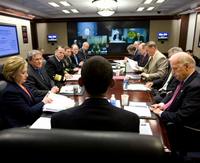
The system we have in place today to ensure the nation’s security from terrorism can be overwhelmingly complex, reflecting a broad diversity of major players and dozens of strategic objectives. This complexity is due, in part, to successive administrations redefining an increasingly intricate web of relationships, roles, and responsibilities, often without rescinding — or fully integrating with — direction established by their predecessors. As a result, the nation’s counterterrorism system has evolved largely in a piecemeal, ad hoc fashion, without the benefit of an overarching strategy or blueprint for how best to organize for success. Over five years ago, the […]
